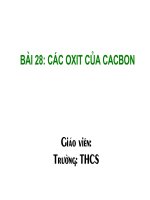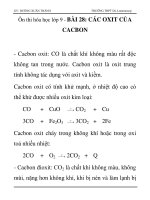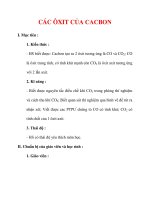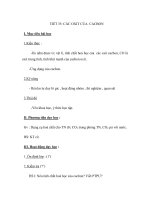- Trang chủ >>
- Văn Mẫu >>
- Văn Nghị Luận
Tiet 34. Cac oxit cua cacbon
Bạn đang xem bản rút gọn của tài liệu. Xem và tải ngay bản đầy đủ của tài liệu tại đây (69.42 KB, 14 trang )
<span class='text_page_counter'>(1)</span><div class='page_container' data-page=1>
<b>Bài 28: Các oxit của cacbon</b>
</div>
<span class='text_page_counter'>(2)</span><div class='page_container' data-page=2>
<b>Néi dung bµi häc</b>
I. Cacbon oxit.
</div>
<span class='text_page_counter'>(3)</span><div class='page_container' data-page=3>
I. Cacbon oxit
<sub> Công thức phân tử: CO</sub>
</div>
<span class='text_page_counter'>(4)</span><div class='page_container' data-page=4>
I. Cacbon oxit
1. TÝnh chÊt vËt lÝ
<sub> Lµ chÊt khÝ không màu, không mùi.</sub>
</div>
<span class='text_page_counter'>(5)</span><div class='page_container' data-page=5>
I. Cacbon oxit
2. Tính chất hoá học
<b> a. CO là oxit trung tÝnh</b>
</div>
<span class='text_page_counter'>(6)</span><div class='page_container' data-page=6>
I. Cacbon oxit
2. TÝnh chÊt ho¸ häc
<b> a. CO lµ chÊt khư</b>
ở nhiệt độ cao, CO khử đ ợc nhiều oxit nhiều kim
loại.
VD:
CO(k) + CuO(r) CO<sub>2</sub>(k) + Cu(r)
đen đỏ
4CO(k) + Fe<sub>3</sub>O<sub>4</sub>(r) 4CO<sub>2</sub>(k) + 3Fe(r)
to
</div>
<span class='text_page_counter'>(7)</span><div class='page_container' data-page=7>
I. Cacbon oxit
2. TÝnh chÊt ho¸ häc
<b> a. CO là chất khử</b>
CO cháy trong oxi hoặc không khí:
2CO(k) + O2(k) 2CO2(k)
</div>
<span class='text_page_counter'>(8)</span><div class='page_container' data-page=8>
I. Cacbon oxit
3. øng dông
<sub>CO đ ợc dùng làm nhiên liệu, chất khử</sub><sub></sub>
<sub>CO còn đ ợc dùng làm nguyên liệu trong công </sub>
</div>
<span class='text_page_counter'>(9)</span><div class='page_container' data-page=9>
II. Cacbon đioxit
<sub>Công thức phân tử: CO</sub>
<sub>2</sub></div>
<span class='text_page_counter'>(10)</span><div class='page_container' data-page=10>
II. Cacbon Đioxit
1. Tính chất vật lí
<sub>Là khí không màu, nặng hơn không khí </sub>
(dCO2/kk=44/29).
<sub>Ng ời ta cã thĨ rãt CO</sub><sub>2</sub><sub> tõ cèc nµy sang cèc </sub>
khác.
</div>
<span class='text_page_counter'>(11)</span><div class='page_container' data-page=11>
II. Cacbon Đioxit
2. Tính chất hoá học
<b>a. T¸c dơng víi n íc</b>
CO2(k) + H2O(l) H2CO3(dd)
Quỳ tím chuyển sang
màu hồng nhạt
</div>
<span class='text_page_counter'>(12)</span><div class='page_container' data-page=12>
II. Cacbon Đioxit
2. Tính chất hoá học
<b>b. Tác dụng với dung dịch bazơ</b>
CO2 + kiềm muèi + n íc
<b>VD: </b>
CO2(k) + 2NaOH(l) Na2CO3(dd) + H2O(l)
CO2(k) + NaOH(l) NaHCO3(dd)
1 mol 2 mol
</div>
<span class='text_page_counter'>(13)</span><div class='page_container' data-page=13>
II. Cacbon Đioxit
Kết luận:
CO
<sub>2</sub>là 1 oxit axit, cã nh÷ng
tÝnh chÊt cđa oxit axit.
</div>
<span class='text_page_counter'>(14)</span><div class='page_container' data-page=14>
II. Cacbon Đioxit
3. ứng dụng
<sub> Chữa cháy, bảo quản thực phẩm.</sub>
<sub> Pha chế n ớc giải khát có ga, sản xuất </sub>
</div>
<!--links-->









